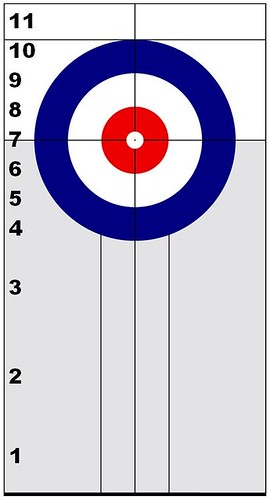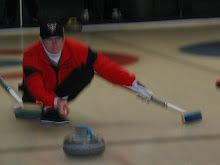 is for Weight. Of the many aspects of the game of curling, perhaps the most difficult to master is weight control - that is, how hard or soft to throw the stone to achieve the desired result. Beginners are generally taught two weights: draw and hit. Draw weight is what one throws to put a rock in the rings, and hit weight is what one throws to take one out.
is for Weight. Of the many aspects of the game of curling, perhaps the most difficult to master is weight control - that is, how hard or soft to throw the stone to achieve the desired result. Beginners are generally taught two weights: draw and hit. Draw weight is what one throws to put a rock in the rings, and hit weight is what one throws to take one out.
Due to the four rock free guard zone rule, and because they start at the lead position, beginners learn, in very short order, that there are actually two draw weights, one to put a rock in the house, and one to put a guard in front of the rings. A few more weeks in, and they will probably be asked to throw a slightly heavier draw weight, intended to tap a rock back without actually removing it from the rings.
A curler who has moved on to join a more competetive team may be asked to throw several new weights in the hit category. Most teams will establish what they call a "normal" hit weight - a default weight for most take-out shots. Some circumstances dictate a change in that weight, and player will eventually be asked to learn to throw a firmer weight shot for situations in which more than one rock is to be moved, or if a long roll is desired, and a lighter weight shot, used when some curl is necessary, or when the team wants to avoid having the shooter roll out of the rings.
 Learning to throw all of these different weights consistently requires throwing many practice rocks over many years. My current team usually uses about eleven different weights. Lessee, there's long guard, tight guard, draw in front of the T, and draw behind the T. Then there's back-line, hack, bumper, control, normal, firm, and peel hit weights. At higher levels of competition, the weights are broken into even smaller demarcations. During the Olympic curling coverage, you might have heard the sweepers calling out numbers as the rocks travelled down the sheet. These numbers were telling the skip where they thought the rock was going to end up. The high level curlers break the in-play area of the curling sheet into ten zones (plus one - see diagram). Those zones are defined as, 1-long guard, 2-halfway guard, 3-tight guard, 4-top twelve foot ring, 5-top eight foot, 6-top four, 7-t-line, 8-back four, 9-back eight, 10-back twelve, and 11-just through. That's in addition to whatever number of hit weight shots they have to master.
Learning to throw all of these different weights consistently requires throwing many practice rocks over many years. My current team usually uses about eleven different weights. Lessee, there's long guard, tight guard, draw in front of the T, and draw behind the T. Then there's back-line, hack, bumper, control, normal, firm, and peel hit weights. At higher levels of competition, the weights are broken into even smaller demarcations. During the Olympic curling coverage, you might have heard the sweepers calling out numbers as the rocks travelled down the sheet. These numbers were telling the skip where they thought the rock was going to end up. The high level curlers break the in-play area of the curling sheet into ten zones (plus one - see diagram). Those zones are defined as, 1-long guard, 2-halfway guard, 3-tight guard, 4-top twelve foot ring, 5-top eight foot, 6-top four, 7-t-line, 8-back four, 9-back eight, 10-back twelve, and 11-just through. That's in addition to whatever number of hit weight shots they have to master.
Now, the throwers are not all alone in trying to put a rock in a certain spot. If you remember our discussion of sweeping, you'll recall that two strong sweepers can extend a rock's travel by up to twelve feet. So, if a thrower can get the rock to within a few feet of its intended target, the sweepers can do the rest. In fact, most skips rely on their sweepers to judge the weight of a running rock, and sweep as necessary to arrive at the right spot. The exception to that, of course, is if one throws the stone too heavy. There is nothing a sweeper can do (legally) to slow down a rock thrown with too much weight.
<- Start at the beginning.
March 03, 2010
The ABCs of Curling - W
Labels:
ABCs of curling
Subscribe to:
Post Comments (Atom)







1 comments:
Detractors need to see stuff like this before they start bawling about how curling has no place in the winter Olympics. Curlers got skilz, yo!
I'm good for some pretty hefty take-out weight, most likely, and I could shout "HURRY HARD!" with the best of them, but that's where it ends for me.
Post a Comment